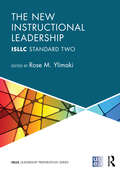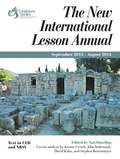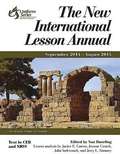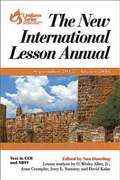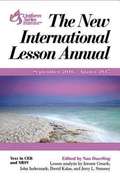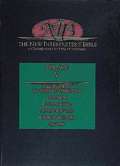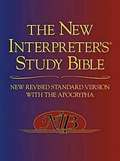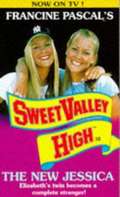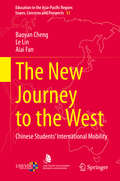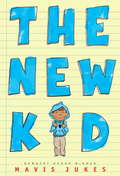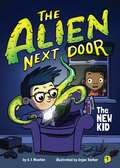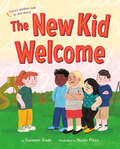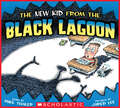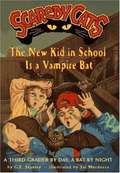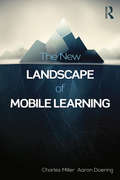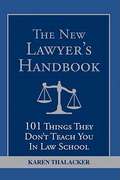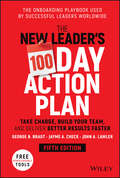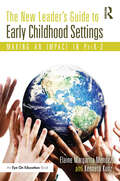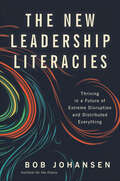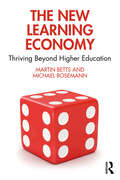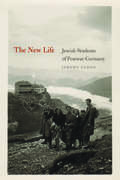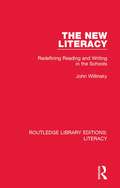- Table View
- List View
The New Instructional Leadership: ISLLC Standard Two (PSEL/NELP Leadership Preparation)
by Rose M. YlimakiCo-published with UCEA, this exciting new textbook is the first to tackle the ISLLC Standard 2—Instructional Leadership. In light of recent curriculum reforms, accountability policies, and changing demographics, today’s leaders must not only have expertise in culture building and supervision skills, but also in adult learning, cultural funds of knowledge, curriculum, and the role of politics. The New Instructional Leadership helps aspiring school leaders examine their beliefs and practices about instructional leadership in relation to ISLLC Standard 2 and provides the theory, learning experiences, and analytical tools for effective leadership in today’s world. Chapters cover issues of collaboration, curricular programming, motivation, supervision, accountability, capacity building, use of technology, monitoring, and evaluation. Special Features: Case Studies—encourage readers to reflect and actively engage with instructional leadership beliefs and practices. Fieldwork and Extended Reflections—a range of inquiry activities provide students with opportunities to consider problems of practice related to the standard. Strategies for Leaders—offers students practical and accessible ideas in order to transform their practice to address the complex challenges facing contemporary schools. Theoretically grounded and research-based, this unique volume will help aspiring and current leaders to understand instructional leadership and help them to sustain strong curricular and instructional programs in their increasingly diverse schools and communities.
The New International Lesson Annual 2013-2014
by Nan Duerling John Indermark Jerome F.D. Creach David Kalas Stephen C. RettenmayerYears of reader evaluations yield a record of overwhelming positive teaching results. Teachers agree that The New International Lesson Annual gets highest marks for helping Christian educators in the classroom, making Scripture understandable or intelligible, relating Scripture to contemporary living, and challenging students to respond with positive life-changing actions. Based on the Bible study foundations of America's leading ecumenical Bible educators and editors in the venerable Committee on Uniform Series. Inside discover: * Easy-to-use design with tint boxes, thumb index, goals for learners, and a key-word pronunciation guide * Easy-on-the-eyes clear type * The only lesson commentary with popular easy-to-understand NRSV and CEB translations (Combined with your own King James Bible, NIV, or any other Bible translation, you have a multiversion parallel.) [Karla, multi- forms a closed compound] * Eight pages of Bible background, interpretation, and step-by-step lesson plans keyed to learner goals for each lesson make lesson preparation thorough without requiring difficult and tedious research * In-depth quarterly teacher enrichment articles and Bible background covering both the big picture and close-up views. Complete index to background Scriptures and occasional additional helps such as maps, charts, and timelines * "Faith in Action" section gives ideas for placing faith concepts of the lessons into action * "Preparing Our Hearts" section with Bible reading and reflection questions for the teacher's personal spiritual growth * "Continue the Journey" section includes ideas for prayer, learner preparation for next week's session, activities the learners can do during the coming week to live out what they have learned, and a suggested closing hymn and benediction * Edited by one of the nation's leading Christian educators, Dr. Nan Duerling
The New International Lesson Annual 2014-2015
by Nan DuerlingYears of reader evaluations yield a record of overwhelming positive teaching results. Teachers agree that The New International Lesson Annual gets highest marks for helping Christian educators in the classroom, making Scripture understood, relating Scripture to contemporary living, and challenging students to respond with positive actions. Based on the Bible study foundations of America's leading ecumenical Bible educators and editors in the venerable Committee on Uniform Series. Lessons for a full year include analysis by leading scholars, four quarterly Bible background articles, a Teacher Helps article, and helps put faith into action. The annual uses NRSV and CEB text.
The New International Lesson Annual 2015 - 2016
by Nan DuerlingYears of reader evaluations yield a record of overwhelming positive teaching results. Teachers agree that The New International Lesson Annual gets highest marks for helping Christian educators in the classroom, making Scripture understood, relating Scripture to contemporary living, and challenging students to respond with positive actions. Based on the Bible study foundations of America's leading ecumenical Bible educators and editors in the venerable Committee on Uniform Series. Lessons for a full year include analysis by leading scholars, four quarterly Bible background articles, a Teacher Helps article, and helps put faith into action. The annual uses CEB and NRSV text.
The New International Lesson Annual 2016-2017: September 2016 - August 2017
by Nan Duerling John Indermark Jerome F.D. Creach David Kalas Jerry L. SumneyThe New International Lesson Annual is designed for teachers who seek a solid biblical basis for each session and a step-by-step teaching plan that will help them lead their classes. It can be used with any student curriculum based on the Uniform Lesson Series. In many classes, both the students and teacher rely on the Annual as their companion to the Bible. Over the four quarters of the 2016-2017 Sunday school year we will explore the themes of God's sovereignty, creation, love, and call. During the fall quarter we examine Isaiah, Hebrews, and Revelation to see how these books reveal the Sovereignty of God. Luke's Gospel, selected psalms, and Galatians will help us understand Creation: A Divine Cycle, our study for the winter. In the spring we will survey both the Old and New Testaments to discover that God Loves Us. We conclude during the summer with God's Urgent Call, a study of the way God spoke to certain judges, prophets, and people of the New Testament. Inside discover: Weekly Scripture reading and reflection questions to enhance the teacher's personal spiritual growth. Weekly activities that the learners can do beyond the classroom to live out what they have learned. In-depth background article for each quarter. Quarterly pronunciation guide. Additional quarterly reference material, such as maps, charts, or timelines. Quarterly ideas for putting one's faith into action. Annual teacher enrichment article. Annual index to background Scriptures.
The New Interpreter's Bible, Volume 5: Introduction to Wisdom Literature, Proverbs, Ecclesiastes, Canticles (Song of Songs), Book of Wisdom, Sirach
by Bruce C. Birch David L. Petersen William L. Lane John J. Collins James Earl Massey Leander E. Keck Thomas G. Long Katheryn Pfisterer Daar Gail R. O'DayIntroduction to Wisdom Literature; Proverbs; Ecclesiates. New Interpreter's® Bible offers critically sound biblical interpretations for the 1990s and beyond. Guided by scholars, pastors, and laity representing diverse traditions, academic experience, and involvement in the Church, this entirely new collection of writings is specifically prepared to meet the needs of preachers, teachers, and all students of the Bible. Easy-to-use Format: * Full texts and critical notes: NIV and NRSV * A detailed, critical Commentary providing an exegetical "close-reading" of the biblical text * Reflections that present a detailed exposition of issues raised in the discussion and dealt with in the Commentary Key Features: * The entire Bible (including the Apocrypha Deuterocanonical books) in twelve volumes * Introductions to each book that cover essential historical, sociocultural, literary, and theological issues * An ecumenical roster of contributors * Comprehensive, concise articles * Numerous visual aids (illustrations, maps, charts, timelines) enhance use. Download The NIB Vol. 5 Errata Sheet
The New Interpreter's Study Bible: New Revised Standard Version with the Apocrypha
by Walter J. Harrelson Donald Senior Abraham Smith Phyllis Trible James C. VanderkamThe New Interpreter's Study Bible brings the best of biblical scholarship to the service of the Church. In this new edition based on The New Revised Standard Version of the Bible with Apocrypha, sixty distinguished scholars have provided background and insight on the biblical text. Features include extensive historical and theological annotations on the biblical text; brief introductions and outlines for each biblical book; excursuses giving further background and insight regarding particular themes and passages; and nineteen newly commissioned maps detailing the biblical world at various historical periods. Available in leather (0687278317) and on CD-Rom (068702496X).
The New Jessica (Sweet Valley High #32)
by Francine Pascal Kate WilliamJessica is tired of being an identical twin, she takes a complete and extreme makeover to become unique. Elizabeth on the other hand then feels as though she's lost her twin forever.
The New Journey to the West: Chinese Students’ International Mobility (Education in the Asia-Pacific Region: Issues, Concerns and Prospects #53)
by Baoyan Cheng Le Lin Aiai FanThis book provides a comprehensive assessment of the cross-border mobility of Chinese students and addresses the questions of who in China chooses to study overseas, why they want to do so, and what the impacts of this mobility are on China’s social stratification. In addition, it explores the challenges that these students face in terms of adaptation and identity formation once they have arrived in the destination country. Adopting a push-and-pull framework to analyze the data, it offers a unique and insightful resource.
The New Joy Of Teaching Discovery In Bible Study (Kids And Christian Education Series)
by Oletta WaldConcentrating on how to teach Bible studies, this resource covers preparation and roles as well as how to work with the learner to create a mutually beneficial learning experience. Get a step-by-step approach to looking at different aspects of the study. The focus is on observation, interpretation, and evaluation. One per leader.
The New Kid
by Larry Dane BrimnerGabby learns a lesson in kindness when she befriends the new girl in school.
The New Kid
by Mavis JukesNewbery Honor Award--winning author Mavis Jukes is back with a lovable new character named Carson. His father moves him to a new town in Northern California, where he'll be the new kid in class--friendless and alone, except for his beloved stuffed moose (named Moose, of course). As Carson settles into his new surroundings, a series of delightful mishaps start to occur: the class pet, a rat named Mr. Nibblenose, gets lost to surprising results; the culprit of a mysterious lunch theft might actually be something that's not human at all; and when his beloved Moose goes missing, Carson makes his first new non-stuffed animal friend. Told with childlike charm and wit, The New Kid is perfect for newly independent readers.From the Hardcover edition.
The New Kid (The Alien Next Door #1)
by A. I. Newton Anjan SarkarIn the first book of the Alien Next Door series, an alien boy named Zeke tries to fit in and adjust to life on Earth, while a classmate, Harris, suspects that Zeke might not be quite what he claims to be. <p><p> Zeke the alien is on his way to his first day of school, feeling down because he has to start over again on a new planet, as his scientist parents constantly move to wherever their research takes them. When he gets to school, no one seems to notice anything strange or different about him except Harris, a kid obsessed with science fiction and aliens. Harris sees Zeke doing extraordinary things but can't convince anyone, least of all his best friend, Roxy, that Zeke might be an alien. Roxy just thinks Harris is jealous that she's becoming friends with Zeke. But when Roxy invites Zeke over to Harris's house, will Harris find a way to prove that he's right?
The New Kid Welcome/Welcome the New Kid
by Suzanne SladeWhen read forward and backwards, this clever and thought-provoking flip-it story demonstrates that there&’s more than one way to think about someone who might seem &“different&” at first glance.It isn&’t easy to say hi to someone new, is it?Told from the perspective of a student, The New Kid Welcome (or Welcome the New Kid when flipped) presents readers with two versions of what happens when a "new kid" joins the protagonist's school. In the first half of the book, the student tells us that they don&’t want to be nice to the new kid or welcome them into their group simply because they seem different. In the second half, the same lines of the story are placed in reverse order. When read this way, the student encourages us to say hello to someone new, saying they will share their table and snacks. With a simple flip of the story, feelings of intolerance give way to those of inclusion and kindness. Precise, thoughtful text and inclusive illustrations combine to create a perfect tool for promoting acceptance and a kinder world. After all... It iseasy to say hi to someone new,isn&’t it?
The New Kid from the Black Lagoon (Black Lagoon Adventures)
by Mike ThalerIt's another scary day at the Black Lagoon. . . .The class is expecting a new kid who comes from far away and Hubie is worried. What if the new kid is from Mars? What if he has purple eyebrows, green antennae, and blue skin? What if he's really coming to take over the world? Or worse, what if he's a body snatcher!Wherever the new kid is from, whatever the new kid is, one thing is certain, he'll fit in fine at the Black Lagoon.
The New Kid in School Is a Vampire Bat (Scaredy Cats #6)
by George E. StanleyNew chills (and chuckles) for the chapter book set! When the arrival of a strange new boy in class coincides with the sudden appearance of bats in their neighborhood, Vincent and Packard suspect that something very weird is aloft.
The New Landscape of Mobile Learning: Redesigning Education in an App-Based World
by Charles Miller Aaron DoeringThe New Landscape of Mobile Learning is the first book to provide a research based overview of the largely untapped array of potential tools that m-Learning offers educators and students in face-to-face, hybrid, and distance education. This cutting edge guide provides: • An essential explanation of the emergence and role of Apps in education • Design guidelines for educational Apps • Case studies and student narratives from across the US describing successful App integration into both K-12 and Higher Education • Robust, research-based evaluation criteria for educational Apps Although many believe that Apps have the potential to create opportunities for transformative mobile education, a disparity currently exists between the individuals responsible for creating Apps (i.e. developers who often have little to no instructional experience) and the ultimate consumers in the classroom (i.e. K-20 educators and students). The New Landscape of Mobile Learning bridges this gap by illuminating critical design, integration, and evaluation narratives from leaders in the instructional design, distance education, and mobile learning fields.
The New Lawyer's Handbook
by Karen Thalacker101 Success Strategies They Didn't Teach You in Law School - get expert advice on becoming a better lawyer. Law school prepares you to think like a lawyer, write like a lawyer, and research like a lawyer-but once you're in the door of a law firm, there's a whole new set of skills you need. The New Lawyer's Handbook guides you through the 101 essential things you need to know in order to excel. From how to handle your clients and how to work with people in your office, to why it pays to learn to play golf and maintain some semblance of a family life even as you make your billables, The New Lawyer's Handbook gives you the knowledge you need to succeed.
The New Leader's 100-Day Action Plan: Take Charge, Build Your Team, and Deliver Better Results Faster
by George B. Bradt Jayme A. Check John A. LawlerMaximize your remote and in-person leadership impact in your first 100 days The New Leader&’s 100-Day Action Plan has sold over 100,000 copies because it's so practical. The author team of accomplished private equity/M&A transition leaders explains in great detail, how to succeed in new leadership roles, build high-performance teams, execute winning strategies, and achieve organizational goals. The heavily revised 5th edition explains how to your due diligence before accepting a new role, and how to lead in remote or hybrid environments and how to leverage diversity, equity, and inclusion to meet team goals, drive growth and enhance any organization. Readers will also find: Roadmaps, tools and tips to understanding, improving, and leading organizational change, including digital initiatives New chapters focused on crisis situations, post-M&A integrations, turnarounds, and transformations Practical counsel on managing your Board A critical resource for leaders in any industry, The New Leader&’s 100-Day Action Plan walks you through your first days, weeks, and months in any new leadership role, when stakes are high and time is of the essence.
The New Leader's Guide to Early Childhood Settings: Making an Impact in PreK-3
by Kenneth Kunz Elaine Margarita MendezLearn how to effectively lead and make an impact in early childhood and primary school settings. The New Leader’s Guide to Early Childhood Settings explores how to empower educators and caregivers, advocate for early intervention, promote culturally responsive teaching, and confront common fears and hurdles. Packed with helpful resources and strategies, chapters feature key tips about effective communication, leveraging technology, and questions for reflection. Practical and accessible, this engaging guidebook delivers quick, effective advice whether you're just starting out or are an experienced leader newly jumping into the early years.
The New Leadership Agenda: Pandemic Perspectives from Global Universities (Asian Higher Education Outlook)
by Martin BettsThis book results from interviews conducted with higher education leaders in Australia, New Zealand, Canada, the US, and the UK. It gives the reader a deep and personal insight into what leaders faced in transforming their universities through the financial shocks, changes in learning practice, and returns to new ways of working accelerated by the upheaval of the COVID-19 pandemic. The features of the book are a series of reflections about issues faced by leaders, recorded, analysed, and reflected on at the time they happened. These are combined in an overall theoretical framework, also informed by other scholarly work in the field, to allow the reader to understand what has happened to our universities and what they will and must do next. For leaders, staff, students, and employers, the book will give an in-depth context, analysed into a simple agenda, to frame future expectations of the changing world of higher education and its implications for leadership in this and other sectors.
The New Leadership Literacies: Thriving in a Future of Extreme Disruption and Distributed Everything
by Bob JohansenOver the next decade, today's connected world will be explosively more connected. Anything that can be distributed will be distributed: workforces, organizations, supply webs, and more. The tired practices of centralized organizations will become brittle in a future where authority is radically decentralized. Rigid hierarchies will give way to liquid structures. Most leaders—and most organizations—aren't ready for this future. Are you?It's too late to catch up, but it's a great time to leapfrog. Noted futurist Bob Johansen goes beyond skills and competencies to propose five new leadership literacies—combinations of disciplines, practices, and worldviews—that will be needed to thrive in a VUCA world of increasing volatility, uncertainty, complexity, and ambiguity. This book shows how to (1) forecast likely futures so you can &“look back&” and make sure you're prepared now for the changes to come, (2) use low-risk gaming spaces to work through your concerns about the future and hone your leadership skills, (3) lead shape-shifting organizations where you can't just tell people what to do, (4) be a dynamic presence even when you're not there in person, and (5) keep your personal energy high and transmit that energy throughout your organization. This visionary book provides a vivid description of the ideal talent profile for future leaders. It is written for current, rising star, and aspiring leaders; talent scouts searching for leaders; and executive coaches seeking a fresh view of how leaders will need to prepare. To get ready for this future, we will all need new leadership literacies.
The New Learning Economy: Thriving Beyond Higher Education
by Michael Rosemann Martin BettsWith a focus on action, this book offers inspiration and pragmatic guidelines to higher education leaders and organisations that want to meet the demands of the changing landscape of knowledge, experience, and learning. Offering a practical toolkit and methodology, this book describes the fast-changing higher education sector as a new learning economy. It explains how this new economy evolved and three major problems that make the current higher education model unfit for purpose. Through six case studies from other contexts, the book presents key lessons for the higher education sector and six strategic principles for growth in this changing environment. The book includes a strategic planning methodology which guides the reader on how to make an assessment of their own institution and identify a strategy for how adaptation and change can realistically be achieved. This book is a must-read for all higher education professionals looking to drive their institution towards an innovative and sustainable future.
The New Life: Jewish Students of Postwar Germany
by Jeremy VaronJewish Displaced Persons (DPs) survived in concentration and death camps, in hiding, and as exiles in the Soviet interior. After liberation in the land of their persecutors, some also attended university to fulfill dreams of becoming doctors, engineers, and professionals. In The New Life: Jewish Students of Postwar Germany, Jeremy Varon tells the improbable story of the nearly eight hundred young Jews, mostly from Poland and orphaned by the Holocaust, who studied in universities in the American Zone of Occupied Germany. Drawing on interviews he conducted with the Jewish alumni in the United States and Israel and the records of their Student Union, Varon reconstructs how the students built a sense of purpose and a positive vision of the future even as the wounds of the past persisted. Varon explores the keys to students' renewal, including education itself, the bond they enjoyed with one another as a substitute family, and their efforts both to reconnect with old passions and to revive a near-vanquished European Jewish intelligentsia. The New Life also explores the relationship between Jews and Germans in occupied Germany. Varon shows how mutual suspicion and resentment dominated interactions between the groups and explores the subtle ways anti-Semitism expressed itself just after the war. Moments of empathy also emerge, in which Germans began to reckon with the Nazi past. Finally, The New Life documents conflicts among Jews as they struggled to chart a collective future, while nationalists, both from Palestine and among DPs, insisted that Zionism needed "pioneers, not scholars," and tried to force the students to quit their studies. Rigorously researched and passionately written, The New Life speaks to scholars, students, and general readers with interest in the Holocaust, Jewish and German history, the study of trauma, and the experiences of refugees displaced by war and genocide. With liberation nearly seventy years in the past, it is also among the very last studies based on living contact with Holocaust survivors.
The New Literacy: Redefining Reading and Writing in the Schools (Routledge Library Editions: Literacy #26)
by John WillinskyOriginally published in 1990. This book examines the innovative programs that changed the way reading and writing was taught during the previous ten years. Both teacher and critic of the New Literacy programs, the author gives a perspective that allows educators, parents, and other readers to assess the promise of these programs. Examining the work of educators from the USA, UK and Canada, he compares programs from first grade to college that foster a new level of literate engagement and voice in students while creating a less authoritative place in which to learn. The book opens up wider debate about literacy in a society concerned with shifting authority from text and teacher to student.
